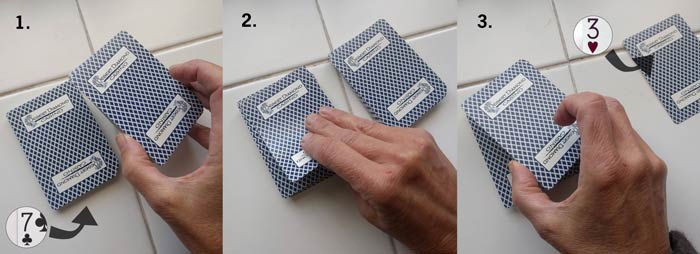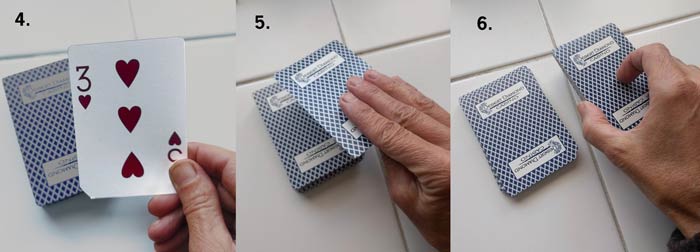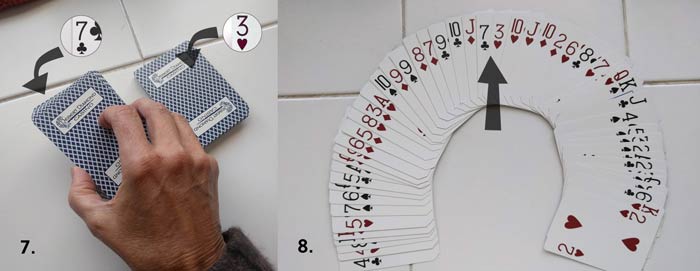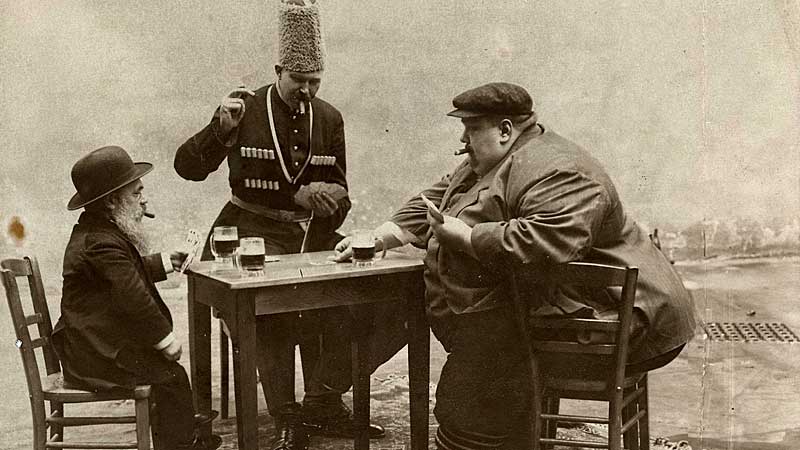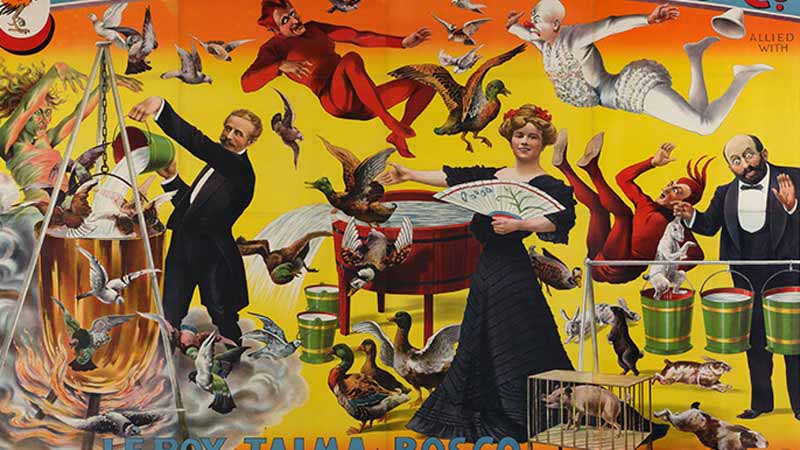Easy Card Tricks to Learn (Magic YOU Can Do!)
SEE ALSO: BEST Card Tricks!
SEE ALSO: BEST Card Magicians!
ALSO: BEST Card Tricks!
ALSO: BEST Card Magicians!
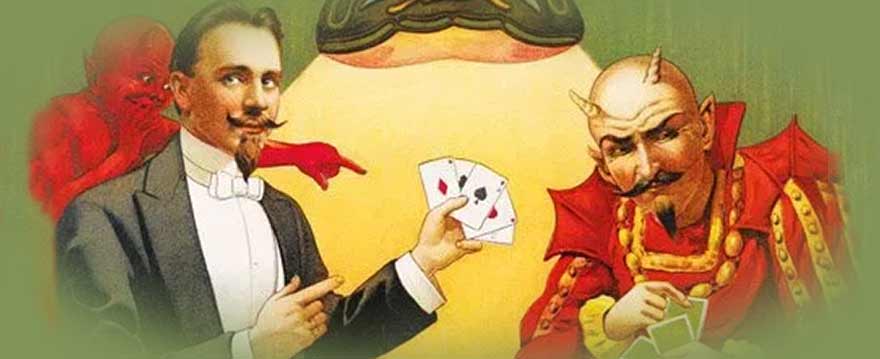
So, you have decided that you would like to impress your friends, make your family feel like you have harnessed dark and supernatural powers, be the life of the party, or woo that significant someone? Great! Maybe card tricks are for you then. If you cannot pass up the lure of the pasteboards, then join us as we explore some principles that you can use to build up your card trick repertoire. These are concepts that you can put into practice right away so you can get in front of some spectators and start building up your performing confidence before you learn harder and harder sleights, for more advanced tricks.
Card Trick Jazz Magic
LESSON 1 - THE KEY CARD
by Dr. Will Given
University of California, San Diego
In Lesson One we take a look at the concept known as the key card and will see how this can be used to build some pretty interesting magic. A key card is a card in a deck that you know the position of that you will then use to know the position of another card, generally one a spectator has selected.

For example, let's say that you give a deck to a spectator and have them shuffle it thoroughly. You want to make sure that they know there is no funny business going on; that the deck is indeed completely shuffled. Once they finish shuffling, have them square the deck which is to give it a good couple of taps on the table to get it all neat and tidy. Catch a glimpse of what the bottom card is. Guess what? All the preparation you need to do is now done. Easy, no? And you haven't even touched the deck at all. So let's look at how this can play out.
PRO TIP: What makes this series different from other "How to Do Card Trick" tutorials is that we don't want you to memorize a bunch of lines (what magicians call "patter"), nor do we want you to memorize a bunch of very complex sleight of hand moves.
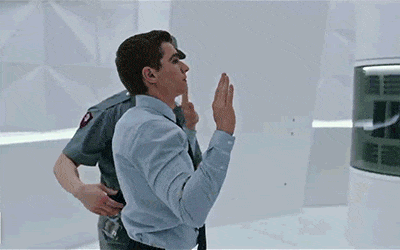
So what's an aspiring card magician going to do? You are going to take your spectators on a journey – one that you have no idea where it leads, but one that is based on the feeling you want to create for your audience. Sound scary? Good! Let's get started.
The spectator has just been handed a deck and has just shuffled it thoroughly. In the process, you have glanced at the bottom card. What can you do with this powerful information? Let's play...
- Tell the spectator to cut the deck to wherever they would like. You can even have them change their mind and cut to a different place if you want. The important thing is the seven of clubs (in our example) that you've already spotted at the bottom of the deck. (figure 1)
- Have them take the card they cut to and set it aside face-down. In this case the three of hearts. Have them "replace the cut" (return the top portion of cards they cut back on top of the deck). (figures 2 & 3)

- Now have them pick up the card they freely cut to and stare at it, not letting anyone else see what it is. Tell them to visualize it in their mind, saying it over and over in their mind, and don't forget it! (figure 4)
- Have them put the card face-down on top of the deck (figure 5), and then cut the deck again. (figure 6)

- Now have them replace the cut, which will put the seven of clubs on top of the three of hearts. (figure 7) Turn the deck face-up and spread the cards out, asking the spectator to be certain that their card is indeed in the center of the deck, and that no trickery has occurred. Make sure they don't reveal what the card is. (figure 8)

Guess what? You now know the card! It is the one directly to the right of the key card that you know. In this case the three of hearts which is next to the key card, the seven of clubs.
An amateur magician might end the trick here and reveal that TADAH, they know what the card is. Not you though! That would be boring. You want to play some jazz. You want to create some magic. Have fun revealing their selected card... Pretend to read their mind, pretend to read their palm or look into their eyes. Have fun revealing THEIR card!
Until next time, play some magic! ♠ ♥ ♣ ♦
LESSON 2 - MAGICIAN'S CHOICE
by Dr. Will Given
University of California, San Diego
Alrightie, ready for another simple yet amazing card trick? You want flavor. You want variety. Here's another method that will allow you to perform completely different type of card tricks.....
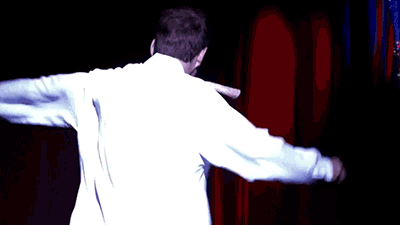
So, how are you going to do that? Well, let's say that you have just performed your improvised Lesson 1 key card routine for Uncle Logan, and he says something like, "but you saw the faces of all of the cards. I don't know what exactly you did, but I know you did something tricky, bub." Now it's time to show him you DON'T need to see the bloody faces of those cards. You are ready to take your magic in an entirely new direction by giving Uncle Logan the perception of free will. Sounds fun, no?
The next concept we are focusing on is called Magician's Choice, or Equivoque as it is also known, is simply where the performer creates the illusion that whatever the spectator may be choosing is, indeed, a free choice. Spoiler alert: it is oftentimes NOT. With Magician's Choice, you are giving the spectator a free choice but you are not exactly telling them what is going to be done with that choice. This makes it seem like the spectator had a completely free choice, but in reality, they do not. Let's look at this in practice...
You are gathering the cards up off of the table when you are issued the challenge by Uncle Logan. In the process of collecting the cards, make sure to catch a glimpse of the top card of the deck (the first card when the deck is turned face-down). Remember this card. Burn this card into your mind. Square up the deck and look Uncle Logan in the eyes. Ask him to cut off about a third of the deck and to be as absolutely precise as possible. Let's imagine that he does so and there are now two unequal packets on the table. Packet 1 is the top third of the deck (and the top card is the card you glimpsed) and Packet 2 is the larger, bottom half of the deck. (figure 1) Point to Packet 2 and ask him to try and cut off an exact third of it too. (figure 2) Tell him this is a game of precision. Here, your jazz improvisational skills can come into play and you can compliment him on the exactness of his cuts, or something else that may fit the tone of the moment.
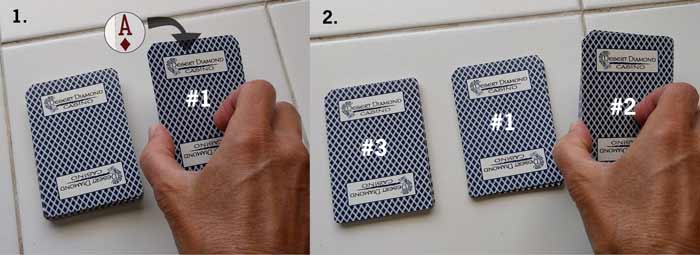
The purpose for commenting on the precision of the cuts is to produce an offbeat in your music, something without emphasis. All of the focus has been downward, toward the table and the cards. This offbeat allows for the spectator's focus to shift up very briefly, toward your face for the joke. Now, when their eyes shift back down toward the deck, there has been an interruption in the visual focus. A punctum. A disruption. This gives enough space to reset the mind, if you will, into perceiving the stacks NOT as the top of the deck, the middle of the deck, and the bottom of the deck, but rather now as three separate packets of cards. All you need to do is remember which of those stacks was the top, or, as we are calling it here, Packet 1.
PRO TIP: I personally have the rule to never make a joke at a spectator's expense, no matter what. Spectators are watching you to be entertained, not to be the focus of a cheap joke. Say in our example above you are looking down not at three equal packets, but rather three packets of varying sizes. I would say something like "the scary thing is you are still way more precise at cutting cards than I am." Here, you are still using the moment of the lack of precision in the cuts for a comedic beat, but the focus of the joke is on you, not on Uncle Logan.
Let's say that Uncle Logan made the first cut and put Packet 1 to the right of the deck (from his perspective). The second cut, Packet 2, he put to the right of Packet 1. Let him put the packets wherever he wants. It's his world. Let him create it. So, if we are seeing them from Uncle Logan's perspective, from his left to right we would have: Packet 3, Packet 1, Packet 2. (figure 2)
Tell Uncle Logan to put each of his hands on a packet, which leaves one untouched. Allow him to change his mind if he wants. It is time for Magician's Choice! There are only three possible combinations here: Packet 3/Packet 1, Packet 3/Packet 2, Packet 1/Packet 2. (figure 3) If he puts hands on Packet 3/Packet 1 or on Packet 1/Packet 2, guess what? He is now touching the face-down card you already know with one of his hands. I want you to reach in and take away whatever packet he is not touching. Say something like, "okay, you don't like this one, let's get rid of it." Throw it over your shoulder. Make a mess. Ask him to raise one of his hands. If he raises the hand on Packet 1, say "alright, we will use that one" and then tell him to throw the other packet his hand is still on over his shoulder. (figure 4) If he raises the hand on the non-Packet 1 packet, then you reach forward and take it and throw it over your shoulder. See, you are definitely giving him a free choice, but you are not telling him what you are doing with that choice. You are not saying "choose a packet" or "which of these packets do you want?" That would be too directive. You are keeping things loose and casual. You are playing jazz.
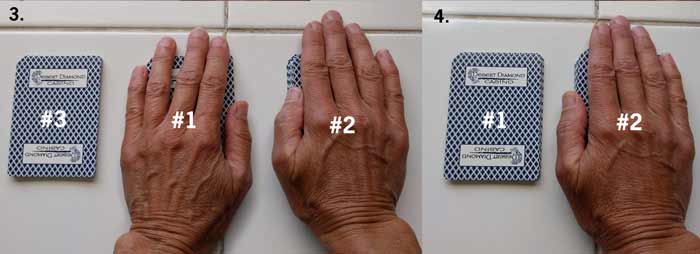
Now, there is just a single packet on the table (Packet 1 – woohoo)! (figure 5) This would be a good time too to remind Uncle Logan that every single thing he has done up to this point has been a free choice. He cut the cards into three equal packets. He chose which packet you are going to use (not technically, but you are doing a tad bit of memory reconstruction for him here so when he thinks back about this later, or tells someone about it, he will equivocate a pseudo-choice into him actually making a definitive choice). Tell him to look at that card. (figure 6) Do not just name his card here. Remember, that would be akin to walking up onto the stage at the jazz show, playing a single note, and then walking off stage. You are going to create some jazz from the seemingly impossible situation of the face-down deck.
You may be wondering what happens if Uncle Logan had originally placed his hands on Packet 3/Packet 2 at the start of all this? You guessed it! You will give him the choice to change and, if he does not, have him grab the two packets he his touching and throw them over his shoulders, leaving only Packet 1 on the table. All roads lead not to Rome, but back to Packet 1.
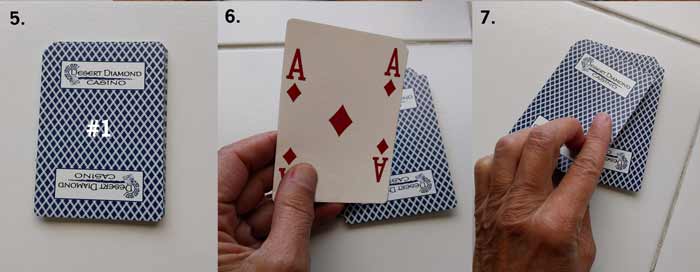
So, how are you going to divine Uncle Logan's card? Your homework is to come up with your most original way to present this and share it with us!
How are YOU going to play some magic? ♠ ♥ ♣ ♦
LESSON 3 - USE THE FORCE
by Dr. Will Given
University of California, San Diego
Welcome back, jazz cats and jazz kittens! Hopefully your homework for Lesson 1 and Lesson 2 has you thinking about some different, creative ways to approach your card magic. The most important concept throughout this entire series is that magic must be personal. It must matter to you. Tricks need to fit who you are as a person. What may work for us may not necessarily work for you and vice-versa.
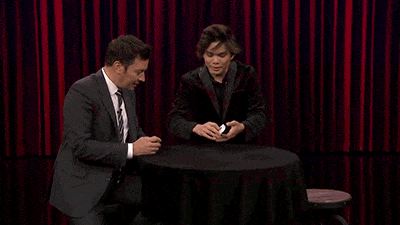
Think of how many times you have seen card magic. What has invariably happened? Someone has said, "pick a card, any card" and you have done so. Is what follows really a surprise? No, not at all. The magician will lose your selection in the deck and then find it. It's that simple. So, why then can card tricks, in the hands of a skilled performer, elicit such wonder? It is because the focus is on the journey the performer is taking you on, and not necessarily on the basics of the trick. Card is lost. Card is found. Tale as old as time.
If you have stuck with us this far, then you may be wanting something a bit more to add to your playing chops. In Lesson 2, we talked about Magician's Choice, and to illustrate it, we used a scenario where the spectator formed three packets of cards on the table. But guess what? In addition to doing Magician's Choice, you were also doing your first sleight! You were doing a Force. Well done, you! You knew what the top card of the deck was, so you forced the spectator to select it using Magician's Choice. Everything happened in the hands of the spectator, allowing you to create your unique magical composition.
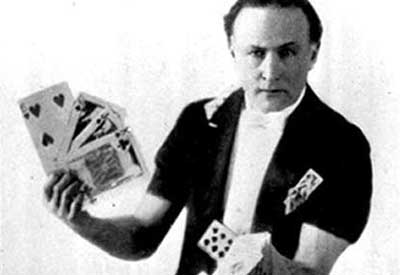
What happens, though, when you are holding the deck? What happens if while you are riffing in your composition, you happen to be shuffling the deck while talking to the spectator? Can you still use the Force to have them select a card that you want them to? You betcha! There are myriad forces one can use in card magic, but for today we are going to focus on just one of them – the backslip.
Are you ready? Grab a deck of cards and let's get started learning your first card sleight! The backslip is a Riffle Force, meaning that you are going to be riffling down through the deck and allowing the spectator to say "stop" wherever they would like. Really. They can stop you wherever. It doesn't matter. Just as in Lesson 2, you are going to need to know one vital piece of information – what the top card of the deck is when it is being held in your hand face-down. (figure 1) Got it? Good.
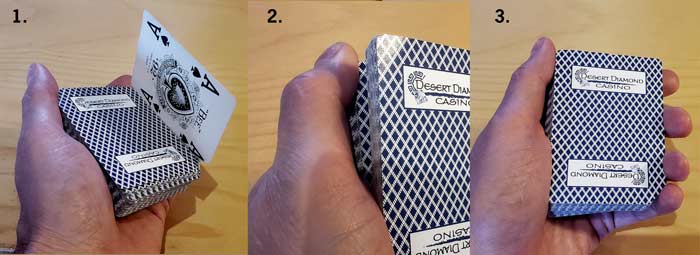
You are going to need to practice actually riffling (figure 2) through the deck for starters. Hold the deck in your left hand. Press the lower-left corner of the deck into the meaty part at the base your thumb. This should allow your thumb to rest naturally along the long side of the deck. Your four other fingers curl around the bottom of the deck and hold the other side. It's a good practice to angle the deck by pushing the top part of it toward the audience. (figure 3) This makes the riffling easier.
With your right hand, grab the deck from above. Press your thumb into the top of the deck, just above center. Now, start riffling through the deck from bottom to top. (figure 4)
PRO TIP: Practice this over and over and over again. Sounds silly, I know, but you want to get very used to this motion. Get to the point where you can feel the individual cards coming off of your fingertips one at a time, no matter how fast or how slowly you are going. When the spectator says "stop," you should be able to stop on a dime.
When the spectator says "stop," and ensures you that is indeed the card they want, you are going to cut the deck into two packets at that point. In the motion of doing so, you are going to move your overhand thumb to the rear short side of the top packet of cards and, with your overhand fingertips still on the front short side of the top packet, you will be splitting the deck in two, keeping the top half pretty much where it is and extending the bottom portion of the deck toward the spectator.
PRO TIP: Practice this motion, before adding the tricky part that follows, to get a sense of how this should actually feel in your hands. This should be one fluid, natural movement.
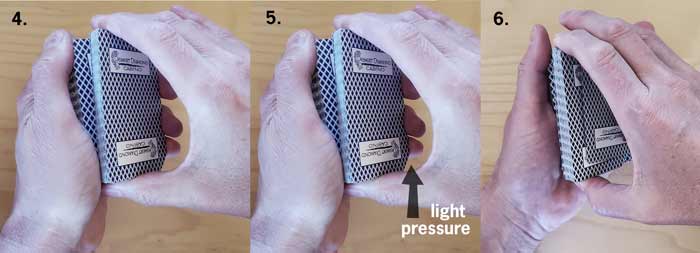
Now for the tricky bit! In the process of extending the bottom half of the deck toward the spectator when the spectator stops you, the pads of your left fingers are going to keep a bit of pressure on the top card (figure 5), allowing you to "strip" it from the top of the deck and slide it with the bottom half. Move your bottom hand to the left half a card width to clear the stripping of the card, but this should not be a large, dramatic movement. (figure 6 - 8) When you move your bottom hand forward, it should look exactly like you stopped riffling when they said "stop" and moved the bottom half forward. The sliding of the top card with the bottom half should be invisible. Remember, you are loose and natural. This shouldn't look like a "move" and definitely shouldn't seem like anything tricky has happened!
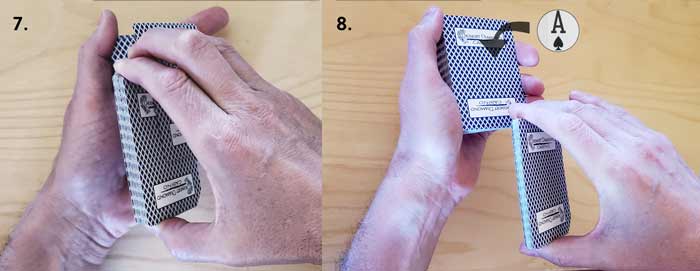
Is this easy? No. Will you make a ton of mistakes learning this? Yes. The stripped card will make a lot of noise when it joins the top of Bottom half. You will strip off more than one card. The cards you strip off will go flying. Be prepared. It is just going to take time and repetition in front of a mirror before you are going to be able to put this into a performance! But just imagine it – with your first sleight, you are now able to force a card on a spectator while they think they have a complete freedom of choice. It is time to play some magic.
I first encountered the backslip when I was reading the book The Royal Road to Card Magic by Jean Hugard and Frederick Braué as a kid. Even though the book was originally published way back in 1948, it is still considered by many (myself included) to be THE starting place if you are serious about learning card magic. The book is still in print, and if you want to pick up a copy for yourself, head on over to Amazon. You won't be disappointed.
Now, as the saying goes, how does one get to Carnegie Hall? Practice. Practice. Practice. ♠ ♥ ♣ ♦
You are on your way to learning some of the greatest easy card tricks of all time but remember.... PRACTICE, PRACTICE, PRACTICE and have fun practicing. Then, when you take a break from practicing, check out the Best Card Tricks of all Time as well as watch some of the Greatest Card Magicians. These will not only give you ideas on how you can create new tricks but inspire you as well.

